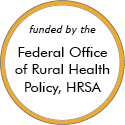Rural Project Examples: Healthcare facilities
Other Project Examples
Montana Interfacility Blood Network (MT IBN)
Updated/reviewed July 2025
- Need: To provide blood transfusions in the ambulance on the way to a hospital.
- Intervention: The Montana Interfacility Blood Network includes 48 healthcare facilities that stock blood and allow ambulances to pick up units of blood while transporting a patient.
- Results: Since its launch, the network has helped at least three patients.
Community Care Partnership of Maine Accountable Care Organization

Updated/reviewed April 2025
- Need: To increase access and quality of care for patients in rural Maine.
- Intervention: Community hospitals and Federally Qualified Health Centers in Maine formed the Community Care Partnership of Maine Accountable Care Organization (CCPM ACO).
- Results: CCPM serves about 120,000 patients in Maine. In addition, it has implemented shared savings arrangements/contracts with different Medicare Advantage and other private health payers.
Regional Behavioral Health Network
Updated/reviewed April 2025
- Need: Multiple organizations in rural east central Illinois needed a more efficient, centralized system for referring patients experiencing a behavioral health crisis to appropriate treatment services.
- Intervention: The Regional Behavioral Health Network was established with a 24-hour toll-free crisis line, providing immediate access to trained crisis clinicians.
- Results: Improved access to high quality behavioral healthcare for patients in rural east central Illinois.
Utah Rural Independent Hospital Network (Rural 9 Network)

Updated/reviewed December 2024
- Need: To help ensure the viability of and improve quality at 9 rural, independent hospitals serving 11 Utah counties.
- Intervention: A network organization was created to allow member hospitals to communicate, network, and undertake projects together.
- Results: Members take advantage of cost savings, education, and networking opportunities through group projects and programs.
The Hospital Cooperative Charge Comparative
Updated/reviewed October 2024
- Need: To help hospitals in rural Idaho and Wyoming see how their prices compare to others in the region.
- Intervention: The Hospital Cooperative (THC) completes an annual charge comparative, which lists the highest, lowest, average, and median price for a specific charge.
- Results: THC has offered these reports since 2010.
The Hospital Cooperative Mobile MRI
Updated/reviewed October 2024
- Need: Critical Access Hospitals in Idaho were not able to afford a fixed MRI system.
- Intervention: The hospitals partnered to purchase a mobile MRI unit to travel among facilities.
- Results: The MRI unit went into service in 2012, providing hundreds of scans per month and traveling among six member hospitals in rural Idaho.
Rural Recruitment Reimagined Workshop Presents the "Safe Sites" Model
Updated/reviewed April 2024
- Need: Strategies to recruit and retain providers to practice in rural settings.
- Intervention: A traveling one-day workshop was designed to share ideas and firsthand accounts on successful strategies on how to create "Safe Sites" for new recruits.
- Results: So far, workshops have trained over 250 hospital administrators, board members, and rural hospital recruiters.
Bozeman Health RV Parking Program
Added February 2024
- Need: To provide a convenient and affordable lodging option for patients who have traveled from a distance to receive medical treatment in Bozeman, Montana.
- Intervention: An RV parking program that lets anyone who is actively seeking care at Bozeman Health Deaconess Regional Medical Center stay in the hospital parking lot.
- Results: Throughout the summer of 2023, at least one patient was using an RV parking space at all times.
Healthy Southern Illinois Delta Network
Updated/reviewed November 2023
- Need: To improve people's health in a rural 16-county region in Illinois.
- Intervention: A coalition of local health departments and healthcare facilities coordinates regional efforts, which are implemented locally by health community coalitions.
- Results: HSIDN has created toolkits, developed resource guides, and provided wellness trainings, among other initiatives.
Georgia Health Initiative's CDFI Investments
Updated/reviewed October 2023
- Need: Across Georgia, especially in rural areas, poor health outcomes and high poverty rates require strategic investments to reduce disparities and improve health across the state.
- Intervention: Georgia Health Initiative invests in Community Development Financial Institutions (CDFIs) working in Georgia to build a strong ecosystem of mission-driven community lenders focused on rural and low-income communities. The capital and capacity building provided by CDFIs support systems change to improve health across the state.
- Results: Since 2017, grants and Program Related Investments (PRIs) in CDFIs working in low-income rural communities have generated impact through stronger and growing Community Health Centers, expanded affordable housing, green energy loans and jobs, and growing small businesses.
For examples from other sources, see:
